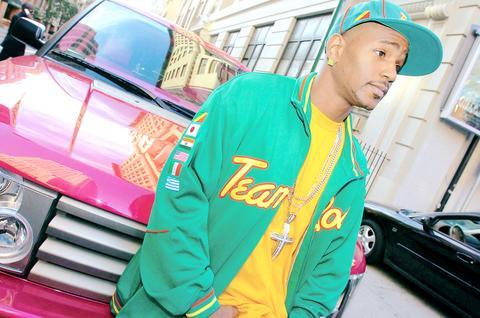In a gated condominium community in Fort Lee, New Jersey, the dense shrubbery suggests a botanical garden more than a residential one. A lantern at the foot of each house's staircase is illuminated before sundown, and there is a late-model sport utility vehicle in nearly every drive. But there is only one hot-pink Range Rover. That is how you can tell the house of Cameron Giles.
For the better part of two years, pink has been the dominant color in the life of Giles, a rapper who performs as Cam'ron. "When I did pink, I did it so I wouldn't be dressing like everybody else," he said. The color seemed guaranteed to set him apart in the world of hip-hop, where men's style tends to conform to notions of hypermasculinity.

PHOTO: NY TIMES
When Giles first wore pink, in the summer of 2002 in a video for Hey Ma and at music industry events, he thought he had found a one-of-a-kind look.
A funny thing happened, though. Not long after Hey Ma began climbing the Top-40 charts, pink began to show up in the wardrobes of other urban young men. At last year's Puerto Rican Day Parade, pink clothing on men offered a counterpoint to the event's macho posturing.
Other hip-hop figures like P. Diddy and Russell Simmons, and the R & B singer R. Kelly, wore pink.
"Cam was the first hard-core rapper to rock pink," said Emil Wilbekin, a former editor in chief of Vibe magazine, who is now an executive at the fashion house Marc Ecko. "What was interesting was how quickly the streets caught on."
Giles himself, however, said he is over the look. He wants to move on. "Me, personally, I haven't worn pink in about four or five months, just for the simple fact that everybody's wearing pink," he said the other day.
He plans to adopt a new color, raising the possibility that he might start a new fad. The sartorial decisions of hip-hop stars strongly affect clothing trends. The fortunes of companies like Tommy Hilfiger and Timberland rose after they were embraced by rap stars, and labels like Sean John and Ecko stake everything on anticipating the urban market.
Giles is cagey about his next big color, hoping to find a way to reap financial gains this time. That might include starting a clothing line of his own. "I'm not going to tell anybody until I patent it," he said of his post-pink color.
"If this many people enjoy my style, and other people want to be fly in the same type of fashion I'm being fly in, then I might as well benefit off it."
It is possible, though, to make an educated guess about Giles's secret. His next album, due in December, is called Purple Haze. A limited-edition cap he designed last summer for the New Era Cap Company featured metallic purple accents. One of his rap crews is called Purple City, a nod to a neighborhood in Harlem and a type of marijuana sold there.
And in April, Giles, in partnership with a company called Harbrew Imports, introduced Sizzurp, a "purple punch liqueur" named for a codeine-laced concoction popular in the South.
Giles, 28, was born and raised in Harlem, and he found fashion at an early age. "Just growing up in Harlem, it didn't matter what you had to do to get fresh, you would do it," he said. "I recall the Skate Key in the Bronx," he continued, referring to a roller disco popular in the 1980s. "You maybe had to go steal your mom's earrings and go pawn them, borrow US$10 from four or five people, but when you got there, it looked like you had $8,000 in your pocket."
In the mid-1990s, he joined his first rap crew, Children of the Corn. Membership required clothes as impressive as one's rhymes -- Sergio Tacchini track suits in particular. "I had to make sure I was on point" around the other rappers, Giles recalled. "They used to go all the way downtown to look for stuff nobody would have. Growing up with them was a privilege."
Giles found stardom as a soloist in 1998 when his album Confessions of Fire went gold. A follow-up, Come Home With Me, in 2002, went platinum and reached No. 2 on the Billboard charts.
Although he has not had the mainstream popularity of P. Diddy or Jay-Z, he is Harlem's most prominent rapper, famous for a sort of avant-garde gangster rap that is dense with polysyllabic rhyme schemes and fashion references.
Giles credits his stylist, Monica Morrow, with introducing him to pink. "I came up with it," Morrow said, "but him putting it on made everyone fall in love with it."

The 1990s were a turbulent time for the Chinese Nationalist Party’s (KMT) patronage factions. For a look at how they formed, check out the March 2 “Deep Dives.” In the boom years of the 1980s and 1990s the factions amassed fortunes from corruption, access to the levers of local government and prime access to property. They also moved into industries like construction and the gravel business, devastating river ecosystems while the governments they controlled looked the other way. By this period, the factions had largely carved out geographical feifdoms in the local jurisdictions the national KMT restrained them to. For example,

April 14 to April 20 In March 1947, Sising Katadrepan urged the government to drop the “high mountain people” (高山族) designation for Indigenous Taiwanese and refer to them as “Taiwan people” (台灣族). He considered the term derogatory, arguing that it made them sound like animals. The Taiwan Provincial Government agreed to stop using the term, stating that Indigenous Taiwanese suffered all sorts of discrimination and oppression under the Japanese and were forced to live in the mountains as outsiders to society. Now, under the new regime, they would be seen as equals, thus they should be henceforth

With over 100 works on display, this is Louise Bourgeois’ first solo show in Taiwan. Visitors are invited to traverse her world of love and hate, vengeance and acceptance, trauma and reconciliation. Dominating the entrance, the nine-foot-tall Crouching Spider (2003) greets visitors. The creature looms behind the glass facade, symbolic protector and gatekeeper to the intimate journey ahead. Bourgeois, best known for her giant spider sculptures, is one of the most influential artist of the twentieth century. Blending vulnerability and defiance through themes of sexuality, trauma and identity, her work reshaped the landscape of contemporary art with fearless honesty. “People are influenced by

The remains of this Japanese-era trail designed to protect the camphor industry make for a scenic day-hike, a fascinating overnight hike or a challenging multi-day adventure Maolin District (茂林) in Kaohsiung is well known for beautiful roadside scenery, waterfalls, the annual butterfly migration and indigenous culture. A lesser known but worthwhile destination here lies along the very top of the valley: the Liugui Security Path (六龜警備道). This relic of the Japanese era once isolated the Maolin valley from the outside world but now serves to draw tourists in. The path originally ran for about 50km, but not all of this trail is still easily walkable. The nicest section for a simple day hike is the heavily trafficked southern section above Maolin and Wanshan (萬山) villages. Remains of